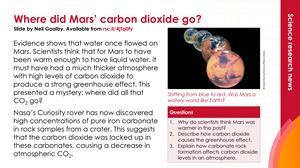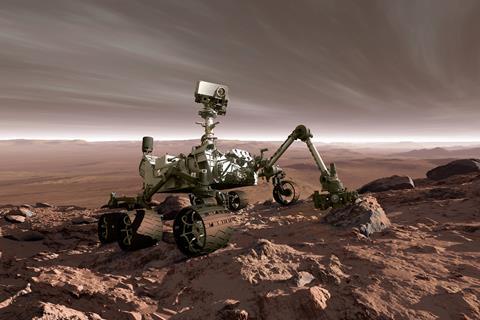Nasa rover finds evidence of carbonate rocks in a dried-up Martian lake that could answer long-held questions about the planet’s past
-

Download this
Use this story and the accompanying summary slide for a real-world context when studying Earth's atmosphere with your 14–16 learners.
Download the story as MS Word or PDF and the summary slide as MS PowerPoint or PDF.

Nasa’s Curiosity rover has discovered carbonate rocks on Mars, helping to solve the conundrum of how the planet was once warm enough to have flowing rivers. These rocks also provide the first evidence of an ancient carbon cycle similar to the one that makes Earth habitable.
Scientists have long believed that in the past Mars was warm enough to host liquid water. To do so, it must have had a much thicker atmosphere than it does today, containing large amounts of carbon dioxide that warmed the planet via the greenhouse effect. However, this theory presented a mystery: where did all that carbon dioxide go?
Nasa’s Curiosity rover has discovered carbonate rocks on Mars, helping to solve the conundrum of how the planet was once warm enough to have flowing rivers. These rocks also provide the first evidence of an ancient carbon cycle similar to the one that makes Earth habitable (rsc.li/3F1BcW2).
Scientists have long believed that in the past Mars was warm enough to host liquid water. To do so, it must have had a much thicker atmosphere than it does today, containing large amounts of carbon dioxide that warmed the planet via the greenhouse effect (rsc.li/4klvzB5). However, this theory presented a mystery: where did all that carbon dioxide go?
This is an exciting result that has large implications for the nature of the early atmosphere on Mars and a Martian carbon cycle
Models had predicted that the gas was probably sequestered in sedimentary rocks in the form of carbonate minerals and that these should be widespread across Mars. However, previous explorations of the planet’s surface by rovers and orbiters, as well investigation of Martian meteorites that have landed on Earth, had revealed only scarce amounts of carbonate minerals.
A mystery solved
The Curiosity rover landed in August 2012 and has now spent more than 12 years on Mars. It carries a suite of analytical instruments for collecting data about the planet that is then beamed back to Earth for analysis. Recently, an international team of scientists found evidence of abundant carbonate rocks just beneath the planet’s surface at the site of a suspected dried-up Martian lake. The data was collected via the rover’s on board CheMin (chemistry and mineral) instrument that uses x-rays to determine the chemical make up of rocks.
‘One of the biggest questions in Mars science is: where are all the carbonates?,’ says team member Benjamin Tutolo, from the University of Calgary in Canada. These newly found rocks ‘may hold a substantial portion of the carbon dioxide that was formerly implicated in warming Mars’, he adds.
‘This is an exciting result that has large implications for the nature of the early atmosphere on Mars and a Martian carbon cycle,’ comments Wendy Calvin, a Mars scientist at the University of Nevada, USA, who was not involved in this work.
This article is adapted from James Urquhart’s in Chemistry World.
Nina Notman
Reference
B Tutolo et al, Science., 2025, doi.org/10.1126/science.ado9966
Download
Summary slide with questions and the article for context when teaching 14–16 lessons on Earth’s early atmosphere and the greenhouse effect: rsc.li/4jTq0ty
Downloads
Curiousity rover finds carbon student sheet
PDF, Size 0.21 mbLocking up CO2 on Mars summary slide
PDF, Size 0.26 mbCuriousity rover finds carbon student sheet
Word, Size 0.83 mbLocking up CO2 on Mars summary slide
PowerPoint, Size 1.44 mb














No comments yet